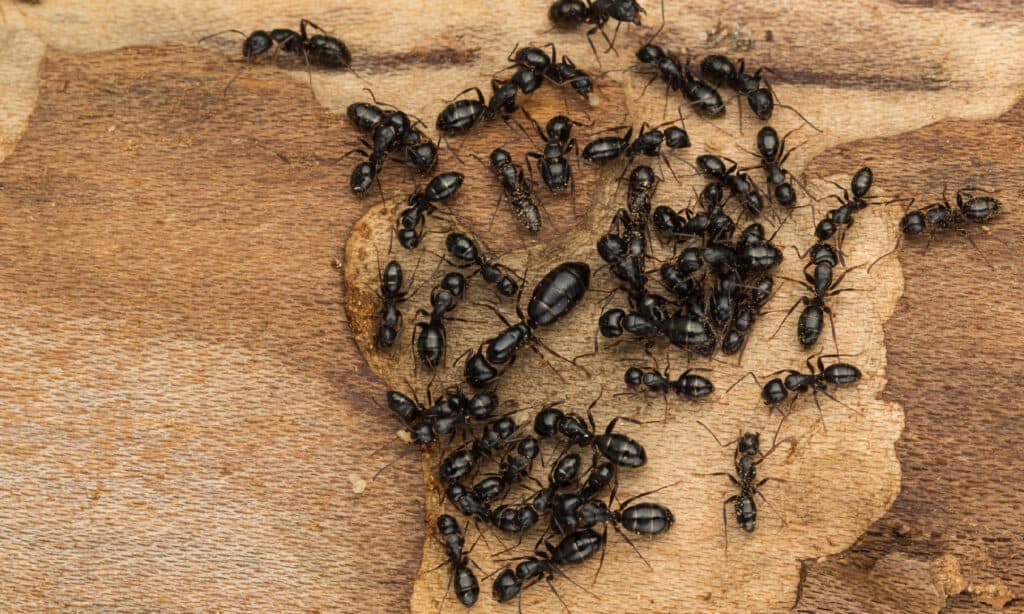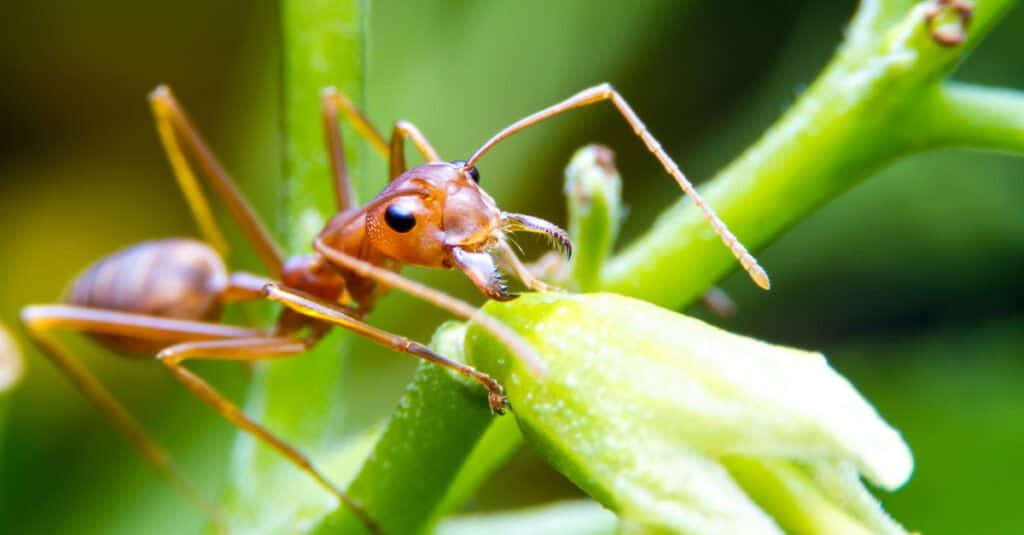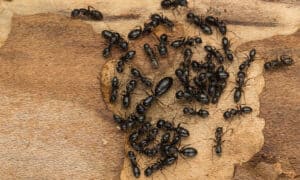Ever had ants invite themselves to your picnic? Sometimes you don’t notice that little trail of tiny, black-bodied insects until they’re making off with larger, more visible items — the crumbs from your meal. It’s not just an image from an old cartoon: when ants find a horde of food, they get organized and start marching off with it, each carrying the biggest morsel they can — it can look like your food has grown legs and started to walk away. Why is it that you only notice the ants once they’re making off with your bounty? It’s because the bounty is often much larger than the ant carrying it — up to 50 times larger! Let’s learn more about how incredibly strong ants are relative to their size, and how that strength compares to human beings and other members of the animal kingdom.
Ants: Tiny But Massively Powerful
An average adult ant barely tips the scales at all: it weighs just 2 milligrams. Yet these unbelievably wee insects have a superpower: their minuscule bodies can nonetheless lift from 10 to 50 times that weight. If a person were that strong, they could easily carry a bull steer!
Why Do Ants Need To Be So Strong?
Ants live in colonies and have highly specialized social roles to play. To tell you the truth, nearly all ants play the same specialized social role: worker ants. The only female who doesn’t work is the queen, and there is only one queen per colony, which might include as many as half a million individual ants. (Things could be worse: you could be a male ant. Yes, all worker ants are females. Male ants have an extremely short life cycle: they’re born, attempt to fertilize a prospective queen, and die.)
Worker ants can have different jobs within the colony: some are tunnel-diggers (picture an ant farm), some are nannies to the queen’s offspring, and others are in charge of scouting out food and bringing it back to the colony. And while only a small percentage of the colony may actually be performing work in a given moment, that work is hard and grueling.
The theory of Darwinian evolution states that over long periods of time, individuals of a species who are more suited to survival survive in greater numbers, causing that species to evolve in more and more specialized ways that are compatible with its environment. Worker ants are a beautiful example of this theory in action. Arising during the Cretaceous Period over 100 million years ago, ants have evolved to the point where their bodies are mostly made up of muscle. And it only follows that this is because muscle is what it takes to crush your daily ant goals, causing your colony to thrive and multiply.

There is only one queen per ant colony, which might include as many as half a million individual ants.
©iStock.com/DianaLynne
How Strong Are Ants Compared to Humans?
We’re talking proportionally, remember; you probably don’t have to worry about giant ants taking over the earth as in Them or that Simpsons episode where Homer goes to space. That said, if you were, say, bitten by a radioactive ant and imbued with ant-like proportional strength, you would find yourself able to lift about 4,000 pounds, or two tons! That’s like being able to pick up a Range Rover with your bare hands.
The Physiology and Anatomy Behind Ant Strength
Let’s take a look at how ants are so strong — or, to put it another way, how their anatomy supports their incredible muscularity.
If you’re reading this, you’re probably a human being, and that means you’ve probably tried to lift something heavy at some point. And if you’re a human over a certain age, you know that you can throw your back out by lifting something that’s too heavy in the wrong way. If you lean down with the top half of your body to collect something heavy from the floor, chances are you’ll pull a muscle in your back torso (your thorax, in ant terms). To avoid this, you have to squat down close to the weight and lift from the knees and backside, not the arms and upper body.
Why does that help? Well, because you’re keeping the weight near your backbone, rather than straining and twisting the spine as it engages the heavy weight from an insecure and awkward position. This principle applies to most of the ways human beings transport heavy things: a backpack slings your possessions across the spine; a baby Bjorn puts your child on your chest (it wouldn’t work well attached to your head or shoulders); a wheelbarrow’s handles bring a heavy container into a comfortable arms’ reach.
This is all because the core muscles are the beginning of all human motion, and they’re arranged around the spine. Ants? Completely different animal. We’ll explain.

Worker ants’ bodies have evolved to be perfectly suited to their daily tasks.
©iStock.com/vnarong
People Have Spines, Ants Have Exoskeletons
Humans and ants are, of course, very different species with completely separate evolutionary journeys. But that’s what can make it so fun to compare us. Imagine that your core is where your neck was. All that amazing strength is now pulsing through your skull and jaw. Whatever you can bench press, you can now hold that same amount of weight between your teeth. Your neck is incredibly powerful, but also amazingly flexible: even with that weight in your teeth, you can twist your neck all the way backward, and further, like an owl. Oh, and you have two additional appendages to stabilize and move your body. You’re an ant!
In short, worker ants have evolved over millennia to the point that their bodies are perfectly suited to the strength-necessitating tasks they face every day. Their heads, equipped with mega-powerful pincer-like teeth known as mandibles, are the biological equivalent of excavating machines. And with that additional leg and bite power, they can not only kill prey thousands of times larger than they are, but carry it home over enormous distances. Compare that to an experienced (human) hiker, who will caution you to never carry more than 20% of your body weight on even a moderate jaunt!
How do ants pack in such colossal strength? The answer, it turns out, is in their small size. It turns out not everything is relative: because ants are so small, it’s easy for them to support a hard exoskeleton. Instead of muscles arranged around a backbone, as in humans, ants have muscles packed densely inside of that hard skeleton. The muscle power required to move such a small package is relatively small. This means those dense ant muscles can devote themselves completely to picking up heavy loads, or biting prey with amazing force.
Ants: Strongest Animal on Earth?
Not even! We told you before that ants can lift up to 50 times their own weight — in human terms, that would be like being able to lift about two tons. Impressed? Then let us introduce you to the Horned Dung Beetle (onthophagus taru). It can lift more than 1,000 times its weight. If you had this kind of strength, you could put down that flimsy SUV you’ve been carrying around and pick up six double-decker buses — full of people!
If you’re talking not relative to body mass, there are a few different contenders for Strongest Animal On Earth: The Crocodile has the most powerful bite. The Gorilla is the strongest primate. The Elephant is the most powerful on land. And the Whale exerts the greatest amount of force. If you want to get even more subjective, the Siberian Tiger is the deadliest hunter; the Hippopotamus is the most powerful herbivore; and the Rhinoceros gets some kind of award for mass times strength times speed (they can get up to 40 miles per hour!). Anacondas probably have the greatest squeezing force. And we’ll round out the list with the Harpy Eagle, the strongest member of the avians. But you could argue that none come close to the organizational strength of ants! (Is that a thing?)
The photo featured at the top of this post is © wnarong/Shutterstock.com
Thank you for reading! Have some feedback for us? Contact the AZ Animals editorial team.







